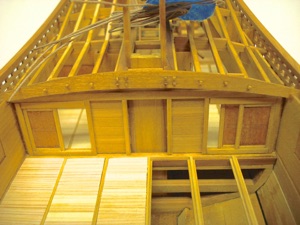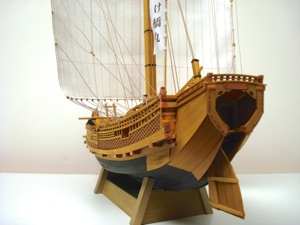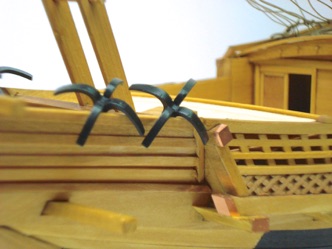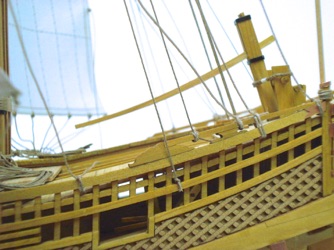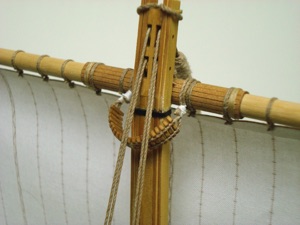Higaki Kaisen, Edo Period Japanese Transport
For those interested in purchasing a kit to build, I recommend the Japanese international hobby dealer Zootoyz. But, in any case, be aware that the instructions are written completely in Japanese. There is heavy use of illustration, but there are parts of the build where a lot of care is needed. Look for my article in Ships in Scale maybe mid-2015 or visit the build notes on my blog site.
Higaki Kaisen, Edo Period Japanese Transport
The Higaki Kaisen (hee-gah-kee-kah-ee-sen) is a regional variation of a type of ship referred to as a Bezaisen (beh-zah-ee-sen) by sailors and ship owners, but they were most commonly referred to as Sengoku Bune (sen-goh-koo-boo-ney), or 1000 koku ship – A koku being the amount of rice needed to feed one person for a year.
These vessel are unique in design, made specifically for coastal operation, unsuitable for use on the open sea. They feature a frameless hull, relying on thick, edge-fastened planking and stout beams. Their hulls had a 5-sided cross-section and no keel, and their rudders were very large and hung from ropes, making them raisable, but also vulnerable to damage in bad weather.
The Higaki Kaisen were vessels operated by the Higaki trade guild of port cit of Osaka, which carried consumer goods to the Japanese capitol city of Edo (now, Tokyo). The name comes from the diamond shaped design which is formed by the lattice work on the hull of the ship.
These vessels had a single large mast which carried a square sail, though smaller sails were often raised on removable masts at the bow.
About the Model
The model itself was built almost straight from a kit by Woody Joe of Japan. The kit, which was released in mid-2013, is not marketed outside Japan, so it a very rare model in the United States. It is a 1/72 scale model, so a person would be just under 1” tall. At this scale, the hull is about 16” long.
The kit relies heavily on laser-cut parts, which works very well for a ship of such unusual design. The bulk of the wood used is hinoki, which is a very aromatic cypress native to Japan. Because of its very light color, I chose to use a custom mix of wood dyes to give the model it’s color. The hull is painted following traditional pattern based on photos of replica vessels and contemporary drawings of similar vessels.
The kit was the subject of a kit review that I wrote for Ships-in-Scale magazine, which appeared in mid-2014. I am also writing an article on the construction of the model, which should be completed by the end of 2015. The model itself appeared on the cover of the Fall 2014 issue of the Nautical Research Journal, which also contained a short photo spread.
This model has been sold to a private collector
Those interested in Japanese style boats should check out the website of American boatbuilder Douglas Brooks, who has studied in Japan and apprenticed with five traditional Japanese boat builders and has written articles and one book on the subject.
The Higaki Kaisen is a type of coastal transport that was the primary means of transporting goods between the port cities of Japan during her 250 year period of isolation.
This 1/72 scale model is built from a recently released kit produced by Woody Joe of Japan. The finished model measures just over 16” high and 16” long.
